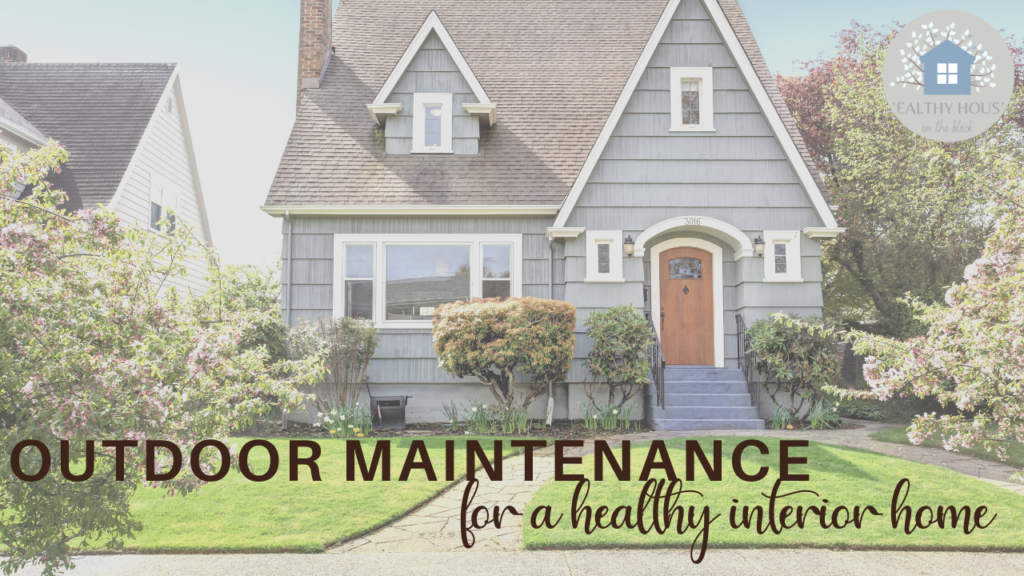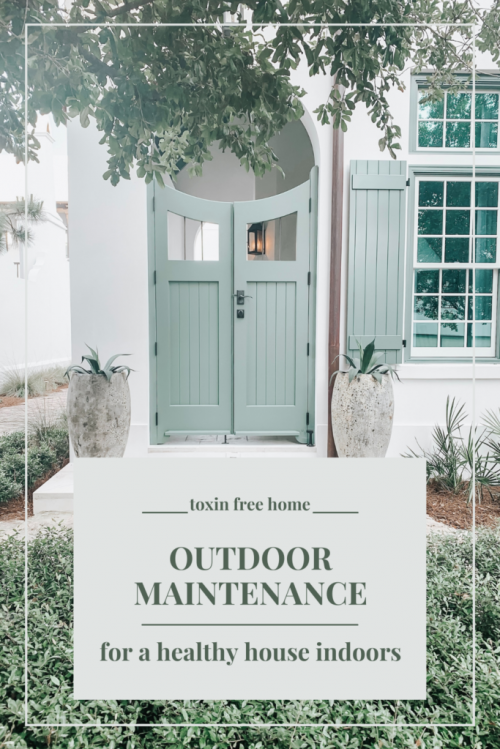
Outdoor home maintenance is definitely not the most exciting or fun part of owning a house. But believe it or not, it’s actually a HUGE part of creating a healthy INDOOR environment. The home systems we have in place work together and can affect other systems if we don’t pay attention to maintenance or small problems that arise. Small annoyances can quickly turn into major red flags if home maintenance items are ignored.
As a home inspector, there are some BIG areas to look at outside. And honestly, these are home maintenance projects that ANYONE can do. You don’t have to be a DIYer or super knowledgeable about your home. The first step is to just get familiar with your home. The more you do these maintenance items and check on areas of your home, the more comfortable you will be caring for your home and creating a healthy indoor space.
I think that getting familiar with your home and its systems is also a great way to train yourself to be able to detect when something may be wrong. And in the same breath, I think it gives you a better idea of issues that you don’t need to panic about, but issues that need to be repaired or attended to.
Outdoor home maintenance is a perfect task for a weekend here or there over the spring and summer, depending on where you live. You can also download my season checklist sheets that will help you walk through your home each season to identify areas that may need attention.
Whether you’re a seasoned homeowner or a newbie at all of this, these outdoor home maintenance items will help you create a healthier interior home as well.

THE BIG OUTDOOR HOME MAINTENANCE ITEMS
Clean Out Dryer Vents: Whether you choose to do it yourself or have a company do it for you, dryer vent cleaning is a quick and easy way to not only reduce your home’s risk of fire, but also improve your indoor air quality. Dryer vents are a place for lint and debris to build up, which can cause a dangerous fire hazard. If your dryer is a gas appliance, the dryer vent also takes combustion gas (CO2 or carbon monoxide) out of your home as well. If this vent is blocked by anything, it will greatly reduce the airflow of these dangerous gasses exiting your home.
First, check your dryer vent from the outside. Make sure there is no lint build up in the dryer vent itself. If there is, you can easily clean this out with a tool or even a gloved hand. Second, if you’re comfortable cleaning the vent from the inside, do this as well. This is where most people like to hire a professional to come and clean the vent on the inside as well.
Either way you choose to do it, removing lint from the exhaust will prevent combustion gas from staying in your home, reduce moisture levels, improve your appliances life expectancy and efficiency and reduce your fire risk.
Clean Out Gutters: Gutters are truly your home’s best friend and they’re so underrated. They not only route water away from your foundation, but also benefit your indoor air quality. This is due to the fact that moisture sitting around your foundation from rain or snow also means your foundation is raising the humidity levels inside your home as well. This is exactly why some basements feel damp and musty. By routing moisture away from the foundation, you can keep the exterior of your home very dry.
Many foundations are made of concrete, either poured or concrete blocks. Concrete can act as a sponge if water comes in contact with it and pull the water through to the other side. This also explains why foundation walls inside can have a lot of moisture on them in some climates.
If your home do has gutters, a few things you can check on regular basis are:
- Make sure gutters are clear from debris
- Make sure extensions on downspouts are attached and running 4-6 feet away from your foundation (downhill is best)
- Check extensions and elbows to ensure there are no blockages preventing water from draining out

Check Grading Around Foundation: Grading around your home is the slope of the soil around the foundation. It’s very important that your home has positive grading, which will allow the water that is near your home flow away from your foundation. If a home has negative grading, where the soil drains towards the house, you’ll no doubt begin to see issues with the foundation in terms of cracking and moisture.
Again, the lower the humidity levels are inside, the better the air quality is as well. You want to keep the humidity levels close to 35% – 40% for optimal indoor air quality. When water is routed away from the home, the foundation isn’t burdened with large amounts of moisture and water that eventually raise the humidity levels inside.
If you live in an area where there is a deep freeze or very cold winter, the water along the foundation ends up freezing and thawing, pushing the foundation wall and putting strain on it. Eventually, you may see cracking in the foundation wall, which allows any Radon gas in the soil to quickly and easily enter your home without a way to escape.
You can easily build up soil around your foundation and level off high areas so the water flows freely downhill, away from your home.
Take Care of Exterior Siding & Trim: Any holes, cracks or areas where siding or flashing are missing can be a spot where moisture and water can freely flow in. It’s also a way that homes become less energy efficient, causing appliances to work harder. Holes also allow bugs, insects and rodents to make their way underneath your siding and possibly into your home. This obviously could bring in bacteria and unwanted health concerns to your home.
Small holes and cracks can be repaired with an exterior silicone or epoxy to keep water away from the underlayment. If your home has a brick exterior, you’ll want to fill it in with mortar to prevent the bricks from becoming too strained. This can compromise the integrity of the bricks, causing more than just moisture issues.
By keeping your home air tight and sealed properly, you can prevent a plethora of problems that arise with poor indoor air quality. It should be noted, however, that if you’re home is very sealed and energy efficient, with no way for air to escape, you can also run into problems with poor indoor air quality. To combat this, you’ll want to make sure fresh air is getting into your home on a regular basis. You can do this through opening windows and running your HVAC fan or through installing an air to air exchange system.

Clean Screens and Filters: So often we forget about our window screens until they are filled with pollen and dust. The summer is a great time to either vacuum or hose them off and get rid of the contaminants that adhere themselves to your screen.
The dirt and dust that travels through the outdoor air can contain allergens as well as pesticides and herbicides from other yards and gardens. That means every time you open up your windows, those contaminants can filter into your home.
Simply vacuuming your screens with a brush may be enough, but for an even deeper clean you can use an exterior window cleaner and attach it to a hose to clean the window and screen outside at the same time.
It’s also important to clean vents and change filters during the summer months. Venting that allows fresh air into our home, or venting that safely displaces combustion gas from appliances can get dirty and plugged over time. Checking these vents and cleaning out dust, debris, lint and other blockages will not only help our home’s indoor air quality, but it can also help our appliances and systems run more efficiently.
Paint or Stain Wood Components: Even modern homes have wood components on the exterior. Many homes will have wood decks, patios or trim somewhere around the house. Keeping the wood sealed can not only help the appearance of your home, but it can also keep the thermal boundary of your home intact.
Wood that is around doors or windows can begin to deteriorate when it isn’t sealed properly with either a paint or a stain. Once the wood begins to deteriorate, which usually begins at the bottom where it gets the most contact with moisture, it continues and eventually ends up affecting larger parts of the wood until it must be replaced.
Once wood begins to deteriorate around your home, it becomes a spot for insects and then animals to use as either a home or feeding ground. Eventually there can be spots in the wood trim that will allow moisture, rain or insects to get behind your siding and affect the home’s barrier between the exterior and interior.
Simply painting or staining wood every few years can help keep a handle on these maintenance tasks.

THE COMPLETE CHECKLIST
One of the biggest pieces of advice I offer to my clients is to walk around the exterior of their house at least every month or so. You might think this sounds like silly advice, but in Minnesota, we just don’t always get outside to walk around the house in the cold winter months when there’s snow to trudge through.
But being diligent about your home maintenance will really help you and your healthy house in the long run. The goal of a healthy house is to be a place with few toxins and lots of pure indoor air. One of the biggest culprits to sabotaging this is moisture and water inside your home. Many of these home maintenance tips are simply tasks to prevent moisture and water inside your home. And often this means starting with checking the outside.

As you walk around your home, here are the things to keep an eye on:
- Are there any cracks, gaps or holes in my foundation walls? If so, use a low toxin exterior epoxy filler to seal in the spots you notice. You can also add a low toxin waterproof coating to the outside of foundation walls to prevent future damage and deterioration from moisture.
- Are there cracks, gaps or holes in my siding or trim? If so, repair the areas with a silicone, wood filler, or stucco repair kit depending on your siding material. Again, sealing over any repairs will help ensure that you won’t be fixing it again in the near future.
- Does the wood trim, siding or decking look worn? Work trim often needs to be resealed or repainted. Keeping up on sealing and painting exterior wood will prolong its life and prevent any moisture from damaging the wood itself or leak through.
- Are the exterior vents blocked or dirty? Screens on exterior vents need to be cleaned at least once a season. Dust and lint (for dryer vents) can block venting as well as insects that build a home on the screens or in the vents. Remove anything that could potentially block air flowing through.
- Are gutters free from debris? Check gutters to make sure that all water is flowing easily to the downspout. Make sure that downspout extensions are also attached and direct water at least 6 feet from your foundation wall.
- Is the air conditioner unit free from debris? Move away any vegetation that has grown around or near the air conditioner to ensure it has ample air flow. Clean out fins with a vacuum or a hose (not a pressure washer). Water should always be sprayed from the inside to the outside of the air conditioner fins.
- Does the soil around the foundation slope away from the home? Make sure that the soil has positive grading so that all water flows out and away from the home. A gradual slope at all sides is ideal for home grading.
- Are outside faucets dripping or pulling away from the home? This may be one you need to call a professional on, but making sure your plumbing outside isn’t leaking will prevent moisture from entering your home and causing big problems.

Remember that keeping on top of your outside home maintenance will help the interior of your home stay free from toxins like mold and toxic dust. The house really does work together as a cohesive unit, and all parts can work together to create the perfect indoor environment.



